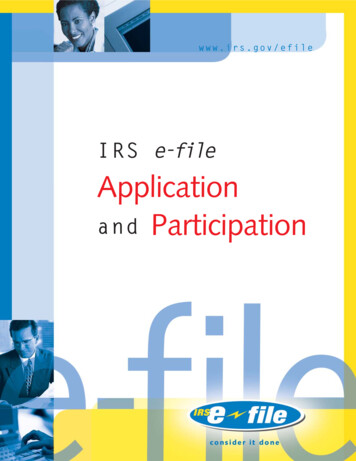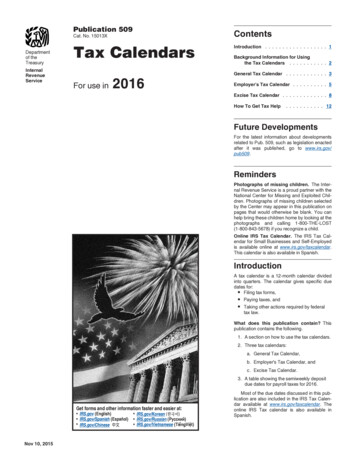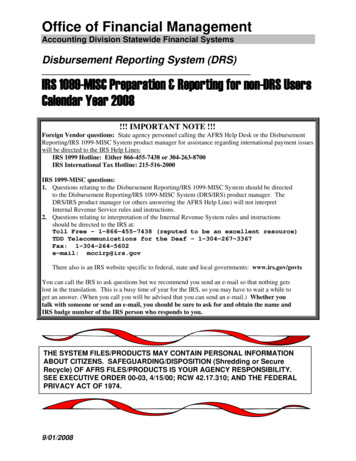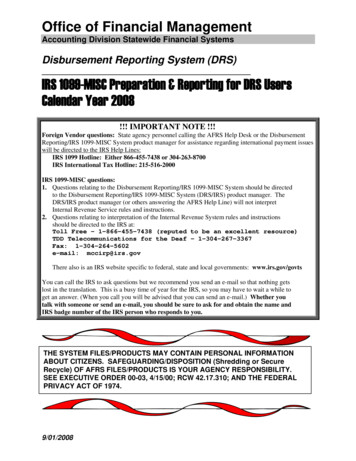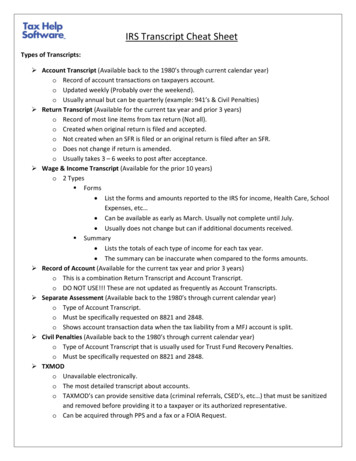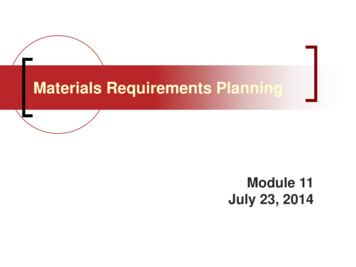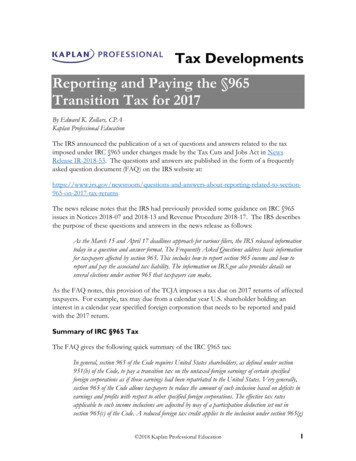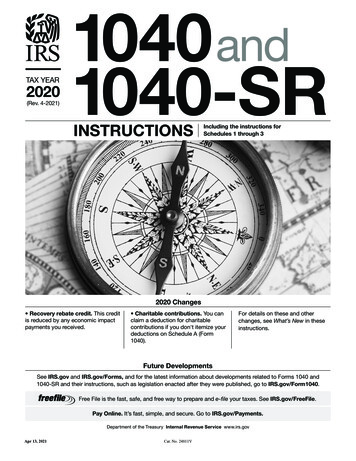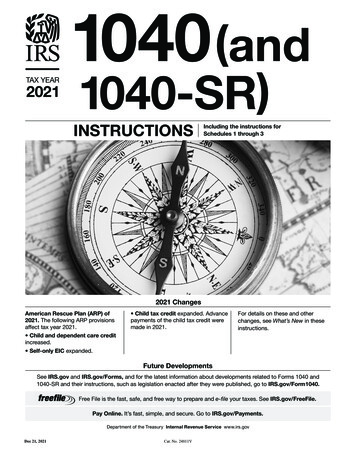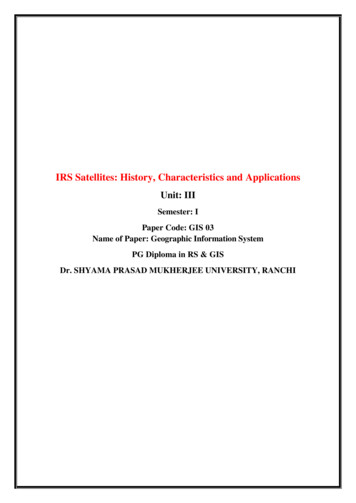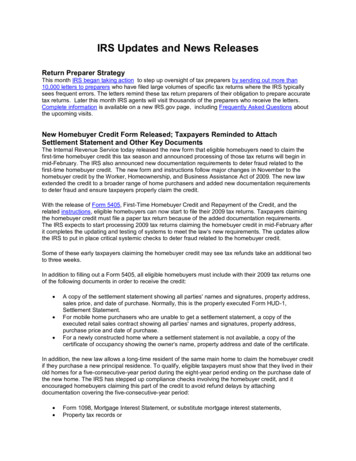
Transcription
IRS Updates and News ReleasesReturn Preparer StrategyThis month IRS began taking action to step up oversight of tax preparers by sending out more than10,000 letters to preparers who have filed large volumes of specific tax returns where the IRS typicallysees frequent errors. The letters remind these tax return preparers of their obligation to prepare accuratetax returns. Later this month IRS agents will visit thousands of the preparers who receive the letters.Complete information is available on a new IRS.gov page, including Frequently Asked Questions aboutthe upcoming visits.New Homebuyer Credit Form Released; Taxpayers Reminded to AttachSettlement Statement and Other Key DocumentsThe Internal Revenue Service today released the new form that eligible homebuyers need to claim thefirst-time homebuyer credit this tax season and announced processing of those tax returns will begin inmid-February. The IRS also announced new documentation requirements to deter fraud related to thefirst-time homebuyer credit. The new form and instructions follow major changes in November to thehomebuyer credit by the Worker, Homeownership, and Business Assistance Act of 2009. The new lawextended the credit to a broader range of home purchasers and added new documentation requirementsto deter fraud and ensure taxpayers properly claim the credit.With the release of Form 5405, First-Time Homebuyer Credit and Repayment of the Credit, and therelated instructions, eligible homebuyers can now start to file their 2009 tax returns. Taxpayers claimingthe homebuyer credit must file a paper tax return because of the added documentation requirements.The IRS expects to start processing 2009 tax returns claiming the homebuyer credit in mid-February afterit completes the updating and testing of systems to meet the law‘s new requirements. The updates allowthe IRS to put in place critical systemic checks to deter fraud related to the homebuyer credit.Some of these early taxpayers claiming the homebuyer credit may see tax refunds take an additional twoto three weeks.In addition to filling out a Form 5405, all eligible homebuyers must include with their 2009 tax returns oneof the following documents in order to receive the credit:A copy of the settlement statement showing all parties' names and signatures, property address,sales price, and date of purchase. Normally, this is the properly executed Form HUD-1,Settlement Statement.For mobile home purchasers who are unable to get a settlement statement, a copy of theexecuted retail sales contract showing all parties' names and signatures, property address,purchase price and date of purchase.For a newly constructed home where a settlement statement is not available, a copy of thecertificate of occupancy showing the owner‘s name, property address and date of the certificate.In addition, the new law allows a long-time resident of the same main home to claim the homebuyer creditif they purchase a new principal residence. To qualify, eligible taxpayers must show that they lived in theirold homes for a five-consecutive-year period during the eight-year period ending on the purchase date ofthe new home. The IRS has stepped up compliance checks involving the homebuyer credit, and itencouraged homebuyers claiming this part of the credit to avoid refund delays by attachingdocumentation covering the five-consecutive-year period:Form 1098, Mortgage Interest Statement, or substitute mortgage interest statements,Property tax records or
Homeowner‘s insurance records.The IRS also reminded homebuyers that the new documentation requirements mean that taxpayersclaiming the credit cannot file electronically and must file paper returns. Taxpayers can still use IRS FreeFile to prepare their returns, but the returns must be printed out and sent to the IRS, along with allrequired documentation.Normally, it takes about four to eight weeks to get a refund claimed on a complete and accurate paperreturn where all required documents are attached. For those homebuyers filing early, the IRS expects thefirst refunds based on the homebuyer credit will be issued toward the end of March.Economic Recovery Payment Contact InformationThe Economic Recovery Payment (ERP) will be a reduction to any Making Work Pay Tax Credit forwhich the recipient qualifies. The Making Work Pay tax credit will be claimed on the recipient's 2009 taxreturn filed in 2010. Taxpayers who can't recall if they received the economic recovery payment shouldcontact their respective agency for confirmation before completing and filing their 2009 tax return in2010. The IRS will not be able to provide this information. If a taxpayer needs to know whether theygot a payment they should contact their respective agency personally.Social Security Administration: Toll Free number 800-772-1213. General ERP inquiries can beanswered by the SSA Web site: www.ssa.gov/recovery.Veterans Administration: Toll free number is 800-827-1000. General ERP inquiries can beanswered by going to the VA Web site: www.va.gov/recovery.Railroad Retirement Board: Go to the RRB Web site at www.rrb.gov/recovery for more details.As a general rule, these agencies will not provide the verification to a returnpreparer who calls the agency independently. These agencies have policies, similarto the IRS, that information is available to a third party representative only if thatindividual is formally authorized to represent the taxpayer with the agency. For taxrelated questions, these agencies will refer callers back to the Recovery Payment pageson our IRS.gov web site and only secondarily be advised to call our toll free number (800-8291040).For more IRS information regarding the economic recovery payment and the MakingWork Pay credit see these questions and answers.Servicewide Key Messages for Tax ProfessionalsThis quarters Servicewide Key Messages for Tax Professionals are now available on irs.gov. Tax returnpreparers perform a vital function in assisting taxpayers in meeting their tax obligations. As a taxprofessional, you have a vested interest (as both a taxpayer and a tax preparer) in the protection of theintegrity of the tax filing system. We are committed to providing tax professionals with the information andtools you need to prepare timely, accurate, and complete tax returns for their clients.The National Taxpayer Advocate delivered her 2009 Annual Report to Congress.National Taxpayer Advocate Nina E. Olson today released her annual report to Congress, warning thatincreased demands on the IRS have eroded the agency‘s ability to meet taxpayer service needs andexpressing concern that IRS collection practices are harming financially struggling taxpayers withoutproducing significant revenue gains. In the preface to the report, Olson noted that she is required bystatute to identify taxpayer problems, but she wrote that ―the IRS in many respects has had an extremely
successful year.‖ She cited, in particular, the IRS‘s success in implementing significant legislativechanges designed to stimulate the economy in the midst of the filing season.Among the key issues and themes identified in this year‘s report:Telephone Service.Examination and Collection Issues.Preparer Regulation.Rethinking the ―Pay Refunds First, Verify Eligibility Later‖ Approach to Tax Returns Processing.Running Social Programs through the Tax System.Related Items:Executive Summary of 2009 Annual Report to CongressComplete Report: 2009 Annual Report to CongressFive Filing Facts for Recently Married or Divorced TaxpayersIf you were married or divorced recently, there are a couple of things you‘ll want to do to ensure the nameon your tax return matches the name registered with the Social Security Administration.Here are five facts from the IRS for recently married or divorced taxpayers. Following these steps will helpavoid problems when you file your tax return.1. If you took your spouse‘s last name or if both spouses hyphenate their last names, you may run2.3.4.5.into complications if you don‘t notify the SSA. When newlyweds file a tax return using their newlast names, IRS computers can‘t match the new name with their Social Security Number.If you were recently divorced and changed back to your previous last name, you‘ll also need tonotify the SSA of this name change.Informing the SSA of a name change is a snap; you‘ll just need to file a Form SS-5, Applicationfor a Social Security Card at your local SSA office.Form SS-5 is available on SSA‘s Web site at www.socialsecurity.gov, by calling 800-772-1213 orat local offices. It usually takes about two weeks to have the change verified.If you adopted your spouse‘s children after getting married, you‘ll want to make sure the childrenhave an SSN. Taxpayers must provide an SSN for each dependent claimed on a tax return. Foradopted children without SSNs, the parents can apply for an Adoption Taxpayer IdentificationNumber – or ATIN – by filing Form W-7A, Application for Taxpayer Identification Number forPending U.S. Adoptions with the IRS. The ATIN is a temporary number used in place of an SSNon the tax return. The W-7A is available on IRS.gov, or by calling 800-TAX-FORM (800-8293676).Social Security AdministrationForm SS-5, Application for a Social Security Card (PDF)Form W-7A, Application for Taxpayer Identification Number for Pending U.S. Adoptions (PDF42K)Payroll Professionals Tax Center - Information for Payroll Professionals and TheirClientsThe IRS has created a new Payroll Professionals Tax Center. This is a one-stop center for anythingrelated to the payroll professionals and their client. IRS.gov now has several Tax Centers designed toprovide relevant tax related information for specific industries and professions. Tax Centers are available
for the Agricultural Industry to the Trucking Industry. A full listing is available on theIndustries/Professions.IRS NationwideTax ForumsTax professionals should make plans to attend the 2010 IRS Nationwide Tax Forums, which will be heldin Atlanta, Chicago, Orlando, Fla; New York, and Las Vegas. Earn valuable CPE or CFP credits, whilegetting the latest updates on key federal and state tax law issues, reconnecting with friends andcolleagues and enjoying networking opportunities. Online registration opens March 1. Program detailsand hotel information have been posted to the internet.New IRS e-file Security and Privacy Standards for Online ProvidersThe IRS has mandated six new security, privacy, and business standards to better serve taxpayers andprotect their information collected, processed and stored by online providers of individual income taxreturns. Although these standards become mandatory on Jan. 1, 2010, there will be an enforcementgrace period until Dec. 31, 2010.Exempt Organization Update1. Rev. Proc. 2010-8: New User Fees for Exempt Organization Matters2. Rev. Proc. 2010-4: Updated Procedures for Issuance of Ruling and Information Letters3. Rev. Proc. 2010-5: Updated Procedures for Issuance of Technical Advice4. IRS Proposes New Requirements for Tax Return Preparers5. Statistical Information of Interest to Tax-Exempt Organizations6. Providing Earthquake Relief to Haiti7. Form 990 Resources and Tools8. Understanding IRS Notices and Letters9. Form 8872 Filing Dates for 201010. Revenue Procedure 2010-9: Determinations and Rulings11. Reminder: File Form 990 Series Returns Timely to Preserve Tax-Exempt Status12. IRS Announces Qualified Disaster Treatment for Haiti13. Register Now! New Small and Mid-sized Workshop Locations Added for Spring14. Haiti Relief Donations Qualify for Immediate Tax Relief15. IRS Issues Electronic Filing Waiver Request Procedures16. Save the Date! 2010 Tax Forums AnnouncedIf you have a technical or procedural question relating to Exempt Organizations, visit the Charities andNonprofits homepage on the IRS.gov Web site. If you have a specific question about exemptorganizations, call EO Customer Account Services at 1-877-829-5500. Subscribe to EO Update.IRS Announces Qualified Disaster Treatment for HaitiIn a News Release the Internal Revenue Service today announced the designation of the earthquake inHaiti in January 2010 as a qualified disaster for federal tax purposes. The agency also issued guidanceallowing recipients of qualified disaster relief payments to exclude those payments from income on theirtax returns. Also, the guidance allows employer-sponsored private foundations to assist victims in areasaffected by the January 2010 earthquake in Haiti without affecting their tax-exempt status.2010 Annual SB/SE Customer Base Survey to BeginThe IRS will begin conducting its annual telephone survey of small business and self-employed taxpayersstarting January 18, 2010 and running through mid-April, 2010. This survey is for small business and selfemployed taxpayers who file certain income tax forms, including: 1120, 1120S, 1065 and 1040 withschedules C, E or F. Completing the survey is strictly voluntary, and all individual responses will remain
anonymous to the IRS. The interviewers from PMR will not ask for any personal or financial information,including Social Security or Employer Identification Numbers, or banking, or credit card information.Purchasing Real Property from a Foreign PersonThere may be tax obligations for both the buyer and the seller when a foreign person sells real property inthe United States.The Health Coverage Tax Credit and the COBRA SubsidySome people who are eligible for the COBRA subsidy, which has been extended through February alsoqualify for the health coverage tax credit (HCTC) and may want to choose this more generous benefit,instead. The HCTC pays 80 percent of health insurance premiums for those who qualify. Eligibleindividuals must be receiving Trade Adjustment Assistance benefits or be over the age of 55 andreceiving pension payments from the Pension Benefit Guaranty Corporation. Individuals must also beenrolled in a qualified health plan.Foreign CorporationsCertain U.S. citizens and residents who are officers, directors or shareholders in a foreign corporationmay be required to file Form 5471, Information Return of U.S. Persons With Respect to Certain ForeignCorporations. Related link: Forms 5471-Automatic Assessment of Penalties under IRC Section6038(b)(1)Justice Department Seeking Injunctions Barring 13 Tax Preparers in Four StatesThe Justice Department announced Jan. 7 that it has filed six civil injunction lawsuits in Michigan, Ohio,Illinois, and Rhode Island against individuals and their tax preparation services to enjoin them fromengaging in a variety of schemes involving false deductions and credit claims.The lawsuits were filed in late December 2009 and early January 2010 and claimed the defendantsfraudulently reduced their customers' federal income tax liabilities. The complaints sought to bar thepreparers from preparing federal returns for others, filing returns for others, and representing customersbefore the Internal Revenue Service.Complaints Filed in Four District Courts.According to DOJ, the following were filed:A complaint filed in the U.S. District Court for Rhode Island against Brier, Jeffrey Sroufe, EstherSantiago, Maria Caroline Halog, Criselyn Rivera, Nitza Benitez, Carmen Miranda, Refunds Now Inc.,RNTS, FTIRS Inc., POTIRS Inc, and IHIRS Inc., claimed the defendants inflated dependentexemptions, claimed fraudulent earned income tax credits, falsified charitable contribution andbusiness expense deductions, and reported false expenses related to rental real estate (UnitedStates v. Brier, D.R.I., No. CA09-607 ML, complaint filed 12/15/09).A complaint filed in the U.S. District Court for the Eastern District of Michigan against Harold K.Solomon, doing business as Solomon Service, said he made false business expense claims andclaimed false or fabricated itemized deductions on more than 1,900 returns (United States v.Solomon, E.D. Mich., No. 2:10-cv-10038-SFC-MAR, complaint filed 1/5/10).A complaint filed in the U.S. District Court for the Southern District of Ohio against Erin Pryor, doingbusiness as EP Express Tax Service, alleged Pryor claimed fraudulent disabled access and earnedincome tax credits as well as false telephone excise tax refund claims on more than 230 tax returns(United States v. Pryor, S.D. Ohio, No. 1:10CV06, complaint filed 1/5/09).A complaint filed in the U.S. District Court for the Northern District of Illinois against Matoi Rimes,doing business as Rimes Accounting Service, claimed Rimes inflated or fabricated itemizeddeductions, rental property deductions, and business expense deductions and misused the refundanticipation loan program for more than 3,100 tax returns (United States v. Rimes, N.D. Ill., No. 1:10cv-00066, complaint filed 1/6/09).
A complaint filed in Northern District of Illinois against Dove claimed he inflated or fabricatedcharitable contribution deductions, inflated or fabricated business expense deductions, and claimedfalse deductions for tuition and rental expenses (United States v. Dove, N.D. Ill., No. 1:10-cv-00060,complaint filed 1/6/09).A complaint filed in the Northern District of Illinois against Bradford and Burkland-Valdez claimed thepair fabricated or falsified employee business expenses, mileage, cash contributions, rental losses,and medical expense deductions (United States v. Bradford, N.D. Ill., No. 1:10-cv-00067, complaintfiled 1/6/09).IRS Announces Streamlined and Simplified Notices to TaxpayersYouTube Video: Received a Letter from the IRS?The Internal Revenue Service today unveiled its first redesigned notices that are part of an on-going effortto improve the way it corresponds with taxpayers. The nine new notices are among the first to bereviewed and revised for clarity, effectiveness and efficiency. The agency also will create an office thatensures the effort to improve communications is on-going and permanent.―One of my priorities is to ensure that we have clear and simple communication with taxpayers. In thepast, our notices often looked more like legal documents and not an effort to communicate clearly. Thedifferences between the old and new notices are like night and day. They show the potential of our ongoing effort in this area,‖ said IRS Commissioner Doug Shulman. In July 2008, Shulman appointed theTaxpayer Communications Taskgroup to review IRS correspondence. The task group found that IRSnotices have different looks, messages and do not use consistent language. Because of this, somenotices are creating unnecessary confusion for taxpayers.Nine notices will feature the new design format beginning in January. These notices account forapproximately 2 million pieces of correspondence with individuals, businesses and exempt organizations.The new format includes a plain language explanation of the nature of the correspondence, clearly stateswhat action the taxpayer must take and presents a consistent, clean design. The new format also guidestaxpayers to appropriate pages on IRS.gov where they can find accurate and relevant information quicklyand easily. By reducing the potential for confusion, these notices will improve the taxpayers‘ ability to getproblems resolved quickly, and improve overall compliance.Shulman also announced this important work will be made a permanent part of the IRS through a newoffice to oversee improvements to taxpayer correspondence. The new office, called Office of TaxpayerCorrespondence, will be directed by Jodi Patterson, who led the initial effort. Tax preparers are alreadyseeing some of this effort. In March, the IRS reduced to 2 from 13 the number of inserts included to taxpreparers as part of notice CP 161, which is mailed to business taxpayers who underpay their taxes.There are approximately 2.3 million CP 161 notices sent annually.Check out the revised Understanding Your IRS Notice or Letter web page on irs.gov.Employee Plans New: Special Edition - January 2010This Special Edition contains the following articles:Cycle D Submission Period Ends on February 1, 2010New Address for Determination Letter ApplicationsApril 30 Deadline for DC Pre-Approved PlansFree Phone Forum on Funding-Based Benefit Restrictions January 26, 2010DOL Corner.
To read the January 2010 Special Edition, please access the newsletter file directly or visit the CurrentEdition of the Employee Plans News page in the Retirement Plans Community section of the IRS.govWeb site.IRS Free File StudyIn an effort to increase the number of individual income tax returns filed electronically, Electronic TaxAdministration and Refundable Credits (ETARC) officials have requested an analysis of taxpayers whousethe Free File program. The Free File program is a free federal tax preparation and electronic filingprogram for eligible taxpayers developed through a partnership between the IRS and the Free FileAlliance, a group of private sector tax preparation companies. Read the full Free File Demographics andMigration Analysis report.2007 Corporation Source Book is now available in two formatsThe 2007 Corporation Source Book is now available in two formats, a CommaSeparated Value (.csv) file and Excel tables. The purpose of the .CSV file, whichcontains only numeric characters, is to provide users a way to download the entireSource Book in one file and use in most statistical software packages. Download andfile use instructions can be found on the website. The Source Book presents balancesheet, income statement, tax, and other selected items by size of total assets for allreturns with and without net income. Statistical tables are available by industrialsectors, major groups within a sector, and minor industries within a major group.Industry detail is based on the North American Industry Classification System (NAICS).Five Ways to Obtain IRS Forms and PublicationsThe Internal Revenue Service has free tax forms and publications on a wide variety of topics. If you needIRS forms, here are five easy methods for getting the information you need.1. On the Internet You can access forms and publications on the IRS Web site 24 hours a day,2.3.4.5.seven days a week, at IRS.gov.By Phone You can call 1-800-TAX-FORM (800-829-3676) Monday through Friday 7:00 am to10:00 pm local time – except Alaska and Hawaii which are Pacific time – to order current yearforms, instructions and publications as well as prior year forms and instructions. You shouldreceive your order within 10 days.At Convenient Locations in Your Community During the tax filing season, many libraries and postoffices offer free tax forms to taxpayers. Some libraries also have copies of commonly requestedpublications. Many large grocery stores, copy centers and office supply stores have forms youcan photocopy or print from a CD.By Mail Order your tax forms and publications from the IRS National Distribution Center at 1201N. Mitsubishi Motorway, Bloomington, IL, 61705-6613. You should receive your products 10 daysafter receipt of your order.Taxpayer Assistance Centers There are 401 TACs across the country where IRS offers face-toface assistance to taxpayers, and where taxpayers can pick up many IRS forms and publications.Visit IRS.gov and go to Contact My Local Office on the Individuals page to find a list of TAClocations by state. On the Contact My Local Office page, you can also select TAC Site Searchand enter your zip code to find the IRS walk-in office nearest you as well as a list of the servicesavailable at specific offices.Publication 910, Guide to Free Tax Services (PDF 636K)Publication 2053A, Quick and Easy Access to IRS Tax Help and Forms (PDF 40K)
Order Publication 1796, Federal Tax Products on CD-ROM, from NTIS — the National TechnicalInformation Service.State tax formsTalking Tax FormsThe Internal Revenue Service has federal tax form formats which are available to individuals who aresight impaired. More than 700 talking federal income tax forms are available on its web site. The speechfriendly forms are easy to use with Microsoft Active Accessibility compliant screen readers and DragonNaturally Speaking Voice Recognition Software. Braille and large-print forms and publications are alsoavailable on-line.New Online Small Business Tax WorkshopThe revised Virtual Small Business Tax Workshop offers updated content with interactive features and anew reference section.IRS Commissioner Discusses Corporate TransparencyIRS Commissioner Doug Shulman discussed corporate transparency at the New York State BarAssociation Taxation Section Annual Meeting in New York City, Jan. 26, 2010.Technical GuidanceAnnouncement 2010-03 provides for plan years beginning on or after January 1, 2009, automaticapproval for certain changes in funding method with respect to single-employer defined benefit plansthat result either from a change in the valuation software used to determine the liabilities for such plans orfrom a change in the enrolled actuary and the business organization providing actuarial services to theplan. This guidance is being provided in response to numerous requests from actuaries and plansponsors, many of whom are continuing to modify their valuation software in order to implement thechanges to the funding rules made by the Pension Protection Act of 2006, the Worker, Retiree, andEmployer Recovery Act of 2008, and guidance regarding these legislative changes.Notice 2010-06 permits taxpayers to correct certain failures of a nonqualified deferred compensationplan to comply with the plan document requirements of § 409A, or in certain circumstances to limit theamount includible in income and additional taxes under § 409A as a result of a plan document failure.Notice 2010-6 also clarifies certain aspects of Notice 2008-113, which addresses failures of nonqualifieddeferred compensation plans to comply with § 409A in operation.Notice 2010-11, Under IRC section 163(e)(5)(F)(iii), the notice extends the suspension of the applicabilityof § 163(e)(5) for certain applicable high yield discount obligations (―AHYDOs‖) to December 31, 2010.Under § 163(e)(5), a corporate issuer‘s interest deduction for original issue discount on an AHYDO isdeferred or disallowed.Notice 2010-12 extends the application of future regulations under section 956, as described in Notice2008-91, 2008-2 C.B. 1001, to an additional tax year beginning before January 1, 2011. Notice 2010-12also extends the application of Rev. Proc. 2008-26, 2008-1 C.B. 1014, which applies to section956(c)(2)(J), to calendar year 2010.Notice 2010-13 updating the procedures for requesting a waiver of the requirement to electronically filereturns when required by regulations and IRS publications. This notice affects corporations and taxexempt organizations that file Form 1120, U.S. Corporation Income Tax Return; Form 1120-F, U.S.Income Tax Return of a Foreign Corporation; Form 1120S, U.S. Income Tax Return for an S Corporation;Form 990, Return of Organization Exempt From Income Tax; Form 990-PF, Return of Private Foundationor Section 4947(a)(1) Trust Treated as a Private Foundation, and returns, amended returns and
superseding returns in the Form 1120 and 990 family of returns that are required to be electronically filed.The notice also reduces the perfection period for rejected e-file returns from 20 to 10 days.Revenue Procedure 2010-12 extends, by two years, the period for temporary guidance regarding certainstock distributions by publicly traded corporations that are regulated investment companies (RICs)or real estate investment trusts (REITs). For stock dividends declared on or after January 1, 2008 andbefore December 31, 2011, the Service will treat a stock distribution by a publicly traded RIC or REITpursuant to a stock-in-lieu-of-money election (under the terms defined in the revenue procedure) as adistribution of property to which section 301 applies by reason of section 305(b), and the amount of suchdistribution of stock will be considered to equal the amount of the money which could have been receivedinstead. In addition, the distribution will not be a preferential dividend under section 562(c).Revenue Procedure 2010-13 requires taxpayers to report to the Internal Revenue Service theirgroupings and regroupings of activities and the addition of specific activities within their existinggroupings of activities for purposes of section 469. Internal Revenue Code Section 469 generallyprovides that income, losses, and credits from an activity will be passive unless the taxpayer materiallyparticipates in the activity. Treasury Regulation Section 1.469-4 allows taxpayers to group activitiesprovided they make up an appropriate economic unit to enable taxpayers to meet the materialparticipation standards.Revenue Ruling 2010-04 provides guidance on whether a tax return preparer is liable for criminal andcivil penalties under Internal Revenue Code sections 7216 and 6713 when the tax return preparer usestax return information to contact taxpayers to inform them of changes in tax law that could affect thetaxpayers‘ income tax liability reported in tax returns previously prepared or processed by the tax returnpreparer; uses tax return information to determine which taxpayers‘ future income tax return filingobligations may be affected by a prospective change in tax rule or regulation and to contact suchtaxpayers to notify them of the changed rule or regulation, explain how the change may affect them, andadvise them with regard to actions they may take in response to the change; or discloses tax returninformation contained in the list permitted to be maintained by the tax return preparer under section301.7216-2(n) to a third-party service provider that creates, publishes, or distributes, by mail or e-mail, taxinformation and general business and economic information or analysis for educational purposes or forpurposes of soliciting additional tax return preparation services for the tax return preparer, for the purposeof obtaining the ‗newsletter‘ creation, publication, and or distribution services offered by the third-partyservice provider.
National Taxpayer Advocate Nina E. Olson today released her annual report to Congress, warning that increased demands on the IRS have eroded the agency's ability to meet taxpayer service needs and expressing concern that IRS collection practices are harming financially struggling taxpayers without producing significant revenue gains.
